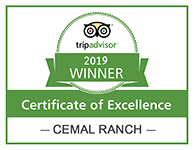About Us
Cemal Ranch is a family owned and operated business, located just minutes from the centre of Ortahisar village in the heart of Cappadocia,Turkey. Cemal, along with his father and brother, have been riding since beforethey could walk and are experts on the riding trails in and around Cappadocia. Their horses are lovingly cared for, sure footed and trail-wise and suitable for all levels of riders from beginner to advanced.
The ranch itself feels like you are 'discovering a little known secret' as despite its close proximity to the village, it's located in a spectacular private 'fairy chimney' valley with amazing panoramas across the countryside. With rustic open air pavilions, sweeping views and barely a road in sight, Cemal Ranch is the perfect setting to relax and enjoy a glass of Turkish tea before or after your horse tour.Cemal takes pride in offering a safe riding environment with well-trained horses and his experience as a guide will ensure your ride is a highlight of your Cappadocian visit.
HISTORY OF CAPPADOCIA
Cappadocia region 60 million years ago; Formed millions years ago by lava and ashes of Ercies, Hasan Mountain and Mount Rouse going through the rains and winds.
The human settlement extends to the Paleolithic turn. The land inhabited by the Hittites is one of the most important centers of Christianity in later periods. Rocky-cut houses and churches have made the area a huge haven for Christians escaping the oppression of the Roman Empire.
The Cappadocia region is a region spanning the provinces of Kırşehir, Niğde, Aksaray and Kayseri, in particular Nevşehir.
The Cappadocia region is an integrated place of nature and history. While the geographical events created the Peribacalari, in the historical process, local people made them houses and churches inside these Peribacas and adorned them with frescoes, making the traces of civilizations thousands of years old. The written history of Cappadocia, where human settlements stretch as far as the Paleolithic turn, begins with the Hittites. Cappadocia is one of the important junctions of the Silk Road, which establishes a commercial and social bridge between countries.
In the 12th century BC, the Hittite Empire collapsed and began a dark period in the region. During this period, Hittite kings now dominate the region with the effects of Phrygia and Assyrian. These kingdoms last until the Persian occupation of the 6th century BC. The name Cappadocia means "Land of Beautiful Horses" in the Persian language. In 332 BC, the Greater Alexandrian Persians defeated, but with great resistance in Cappadocia. In this period, the Kingdom of Cappadocia is established. Towards the end of the 3rd century BC, the power of the Romans begins to be felt in the region. In the mid-1st century BC the Cappadocian Kings were appointed with the power of Roman generals and reduced from the throne. When the last king of Cappadocia dies in 17 A.D., the region becomes a province of Rome.
The 4th century is the period of people who were later called as "Father of Cappadocia". But the prominence of the region is the Roman Emperor III. Leon's icon reaches its peak by forbidding. In the face of this situation, some pro-icon people begin to take refuge in the region. Iconoclasm movement lasts more than a hundred years (726-843). Although a few Cappadocian churches were influenced by Iconoclasm during this period, those who were against Iconoclasm continued their worship without any problem. The Cappadocian monasteries were very evolved in this period.
Again during these periods, Arab raids started from Armenia to Anatolian Christian regions including Cappadocia. People who came with this streams cause the churches in the region to change their style. In the 11th and 12th centuries, Cappadocia is in the hands of the Seljuk Turks. In this and the subsequent Ottoman Empire period, the region has a problem-free period. The last Christians in the region migrated from Cappadocia in 1924-26 due to the Lausanne Treaty, leaving beautiful architectural examples behind them.
HISTORY OF CAPPADOCIA
Today, the Cappadocia region has great potential in terms of international and local tourism.The following places are a 'must see' for those visiting the region- Urgup, Avanos, Goreme Open Air Museum, Akvadi, Uçhisar and Ortahisar Kaleleri, Güvercinlik Valley, Derinkuyu and Kaymaklı, Underground Cities, Ihlara Valley, Selime Village, Çavuşin, Güllüdere Valley, Paşabağ and Zelve.
These villages and valleys express the uniqueness of traditional Cappadocian architecture as well as showcasing the carving of homes and dove cotes in the rocks and valleys.
The dovecotes are small carved structures built in the late 19th and early 18th centuries into many of the rock surfaces.The outer area of these were decorated with rich ornaments and inscriptions by local artists as well as a rare few that are decorated with important Islamic painting art, similar to the more famous fresco-ed churches and monasteries of Cappadocia .
The architectural stone of the region is volcanic so it is soft and very easy to work with although after it comes into contact with the air it hardens and becomes a very durable building material. Because the stone is easy to work with the art of stone craftsmanship has become an architectural tradition with many of the local houses beautifully decorated above the doors and windows with a variety of local motifs of stylized ivy or rosettes.
What to do in Cappadocia?
- Hot-air balloon flight -A once in a lifetime experience soaring at sunrise, above the spectacular lunar landscape of Cappadocia.
- Göreme's Open Air Museum - the region's most famous concentration of ancient frescoed rock churches.
- The Underground Cities - Carved beneath the earth - the larger cities descend to 8 levels through a maze of tunnels.
- Traditional Turkish Night-An entertaining night showcasing turkish folk dance and belly dancing set in a unique underground cave venue.
- Day Tour to the valley of Ilhara - at the foot of Hasan Dagi volcano, this long, lush canyon is studded with ancient rock churches and monasteries.
- Day Tour to the valley of Soganli - off the beaten track,the 'valley of the dolls' as Soganli is known is home to churches and dovecotes unique in Cappadocia.
- Wine testing in Cappadocia's vineyards- Cappadocia is famous in Turkey for the quality of wine.
- Visit to local craft shops and workshops for handmade carpets, kilims, pottery, jewellery. All unique to Cappadocia.
- Traditional Turkish Bath - Steam bath and massage at the hamam- a unique and revitalizing experience after a day of horse riding.
Come for breakfast or lunch....or all day!
The charming ranch house is a perfect place to enjoy traditional Turkish dishes cooked by Cemal's mother. She personally cares for every guest, serving local dishes accompanied with homemade organic jams, grape syrups and Turkish spicy tomato salsa. Many guests come back to Cemal Ranch on a regular basis just to enjoy her leisurely brunches with family and friends.
We are highly recommended
Cemal Ranch is highly recommended on Trip Advisor and is featured in many guide books including Lonely Planet's Turkey Guide.









